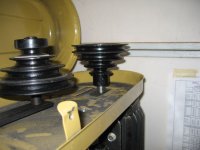TonyS
Plastic
- Joined
- Jan 25, 2009
- Location
- California, USA
I'd like to convert my belt-driven woodworking drill press to variable speed using a VFD. The machine is a Powermatic 2000, a 20" model with speeds between 130 and 2770 rpm and a 1.5HP (advertised) motor; it sees light use. For the new motor I have an unused 1.5HP 220V 3PH 1740 rpm inverter-rated TEFC Leeson motor, bought for a song on ebay to test the output of an RPC I built awhile back.
After some reading on this forum I have drawn some tentative conclusions:
1) Running this motor up to around 3000 rpm through the VFD should be no problem, so a single pulley ratio could perhaps be used to provide a speed range of 100 to 3000 rpm.
2) Running below a few hundred rpm for too long may cause the motor to overheat. At what point this occurs is dependent on the type of VFD.
3) A second pulley ratio could be used to reduce the speed if/when necessary to avoid the overheating problem, but the point of this exercise would be to avoid using it.
Questions: Am I on track? How long before it's 'too long' and overheating becomes an issue at low rpm? Can I monitor it by putting a hand on the motor? Is it worth the extra money to get a better VFD (sensorless vector)? If so, what drive would suffice without breaking the piggy bank?
Thanks,
Tony
After some reading on this forum I have drawn some tentative conclusions:
1) Running this motor up to around 3000 rpm through the VFD should be no problem, so a single pulley ratio could perhaps be used to provide a speed range of 100 to 3000 rpm.
2) Running below a few hundred rpm for too long may cause the motor to overheat. At what point this occurs is dependent on the type of VFD.
3) A second pulley ratio could be used to reduce the speed if/when necessary to avoid the overheating problem, but the point of this exercise would be to avoid using it.

Questions: Am I on track? How long before it's 'too long' and overheating becomes an issue at low rpm? Can I monitor it by putting a hand on the motor? Is it worth the extra money to get a better VFD (sensorless vector)? If so, what drive would suffice without breaking the piggy bank?
Thanks,
Tony




